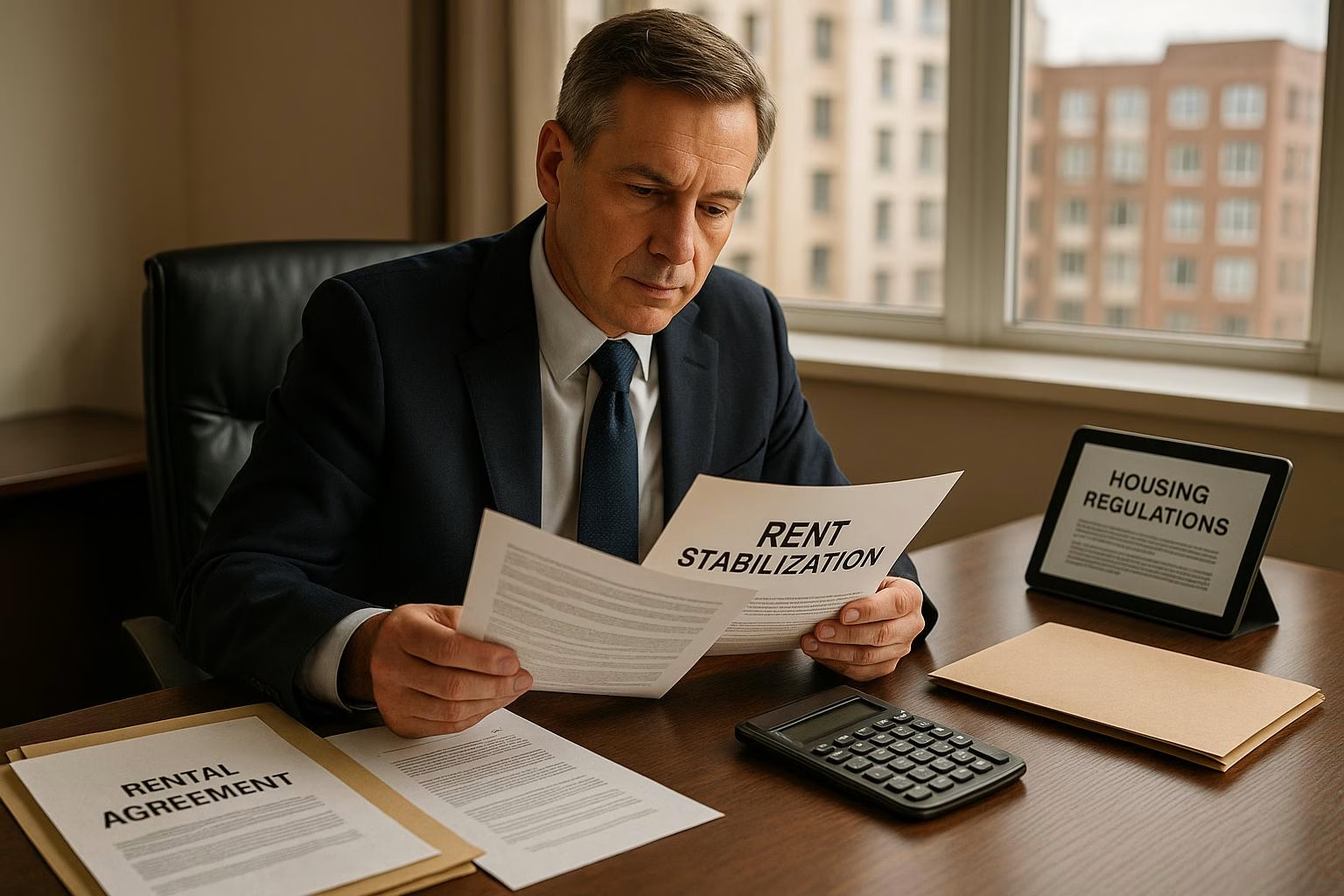Rent stabilization is a system of laws that limits how much a landlord can increase rent. Its primary goal is to keep housing affordable for tenants. These regulations provide a measure of predictability for renters.
It is important to distinguish rent stabilization from rent control. Rent control is typically a stricter set of regulations that freezes rent at a certain price. Rent stabilization, on the other hand, allows for controlled, annual rent increases.
What is Rent Stabilization?
Rent stabilization policies are designed to protect tenants from sudden, large rent hikes. They establish a maximum allowable percentage for rent increases. This helps to maintain a stable rental market for both tenants and landlords.
These regulations often apply to specific types of buildings, such as those of a certain age or size. The rules can vary significantly from one jurisdiction to another. As a property owner, it is essential to understand the specific laws in your area.
In practice, rent stabilization means that landlords can only raise rents by a certain percentage each year. This percentage is often tied to the Consumer Price Index (CPI) or another measure of inflation. This ensures that rent increases are tied to economic realities and not arbitrary decisions.
For example, a local rent board might determine that the allowable rent increase for a given year is 3%. This means that a landlord with a rent-stabilized unit currently renting for $2,000 per month could only increase the rent to $2,060. This predictable model of increases helps tenants budget and plan for the future.
The Legal Considerations of Rent Stabilization
The prevalence of rent stabilization laws varies across the United States. A handful of states, including California, New York, New Jersey, and Maryland, have localities with some form of rent stabilization. These laws are most common in densely populated urban areas where housing costs are high.
In California, the Tenant Protection Act of 2019 established statewide rent stabilization, limiting annual rent increases to 5% plus the local CPI, with a cap of 10%. However, many cities in California, such as Los Angeles and San Francisco, have their own, stricter rent stabilization ordinances. This creates a multi-layered legal framework that landlords must navigate.
Conversely, a majority of states have laws that prohibit local governments from enacting rent control or stabilization measures. According to the National Multifamily Housing Council, over 30 states have such preemption laws in place. This creates a diverse and sometimes complex legal environment for property managers to operate within.
Key Provisions of Rent Stabilization Laws
Rent stabilization ordinances typically include several key provisions that property managers must understand. These laws grant tenants specific rights and protections. One of the most significant is the right to a lease renewal.
Tenants in rent-stabilized units generally have the right to renew their lease, preventing arbitrary non-renewals. This provides tenants with a sense of security and stability. These laws also provide eviction protections, requiring landlords to have a valid reason, or “just cause,” for an eviction. This could include non-payment of rent, a material breach of the lease, or the owner’s intent to occupy the unit.
For landlords, these laws impose limits on the size of rent increases. They also often come with requirements to maintain the property at a certain standard. This is often referred to as the “warranty of habitability,” which requires landlords to keep their properties in a safe and livable condition.
Furthermore, many rent stabilization laws include provisions for capital improvements. If a landlord makes a significant improvement to a building, such as replacing the roof or installing a new boiler, they may be able to pass on a portion of the cost to tenants in the form of a temporary rent increase. However, these increases are typically subject to strict regulations and must be approved by the local rent board.
The Pros and Cons of Rent Stabilization
Rent stabilization presents a mixed set of outcomes for the rental market. For tenants, the primary benefit is protection from large and unpredictable rent increases. This can lead to greater housing security and community stability, allowing families to put down roots and contribute to their neighborhoods.
For landlords and real estate investors, rent stabilization can present challenges. Limits on rent increases may reduce the potential return on investment, making it more difficult to cover rising operating costs. Some studies suggest that these policies can also discourage new construction and investment in property maintenance, as landlords may have less incentive to improve their properties if they cannot recoup the costs through higher rents.
A 2019 study on rent control in San Francisco found that while it helped to reduce the displacement of existing tenants, it also led to a 15% reduction in the supply of rental housing as landlords converted properties to other uses. This highlights the complex effects these policies can have on the housing market. It is a delicate balance between protecting tenants and ensuring that landlords have the financial means to maintain their properties and a viable business.
Another consideration for landlords is the administrative burden of complying with rent stabilization regulations. The paperwork and reporting requirements can be time-consuming and complex. This is why many landlords choose to hire professional property managers who are well-versed in the local laws and can ensure compliance.
How to Comply with Rent Stabilization Regulations
Compliance with rent stabilization laws is crucial for any property manager or landlord operating in a regulated area. The first step is to determine if your property is subject to these regulations. Local rent boards or housing authorities are the best source for this information. You can often find this information on their websites or by calling their offices.
If your property is rent-stabilized, you must follow the specific procedures for setting and increasing rent. This typically involves using a percentage determined annually by a local rent guidelines board. The NYC Rent Guidelines Board is one example of such a body. It is imperative that you use the correct percentage and provide tenants with proper written notice of any rent increase.
Maintaining clear records of rent increases and communication with tenants is also essential. Proper documentation can help to prevent disputes and demonstrate compliance in the event of an audit or legal challenge. Always consult with legal counsel to ensure you are adhering to all local ordinances. A real estate attorney who specializes in landlord-tenant law can be an invaluable resource.
It is also important to stay informed about any changes to rent stabilization laws in your area. These laws can and do change, and it is your responsibility as a landlord or property manager to stay up-to-date. Subscribing to industry newsletters and joining local landlord associations can be a good way to stay informed.
Frequently Asked Questions
What is the main difference between rent control and rent stabilization?
Rent control typically freezes rent at a specific price, while rent stabilization allows for limited, annual increases based on a set percentage. Rent control is a much rarer and more rigid form of regulation.
How do I know if my property is subject to rent stabilization?
You can check with your local housing authority or rent stabilization board to determine if your property falls under these regulations. They will have specific criteria based on the age, size, and location of your building.
Can I evict a tenant from a rent-stabilized apartment?
Evictions are generally restricted to specific “just cause” reasons, such as non-payment of rent or a significant lease violation. You cannot simply decide not to renew a lease without a valid, legally recognized reason.
Are there any exceptions to rent stabilization laws?
Some laws exempt certain types of buildings, such as new construction or owner-occupied properties with a small number of units. These exceptions vary by jurisdiction, so it is important to check your local laws.
Where can I find more information about rent stabilization in my area?
Your local or state housing authority website is the best resource for detailed information on rent stabilization laws and regulations. You can also consult with a local real estate attorney for guidance.
Are you looking to connect with property owners, landlords, and real estate investors?
Grow your business by connecting with property professionals with our cost-effective advertising options.

Discover the secret to stress-free property management with How To Find & Keep Great Tenants. This essential guide reveals proven strategies for attracting high-quality renters and creating long-term, mutually beneficial relationships.
But finding great tenants is only half the battle. Uncover the art of tenant retention, from creating a positive living environment to addressing concerns promptly and professionally.
With this book, you’ll transform your rental property into a sought-after home that tenants won’t want to leave. Minimize vacancies, reduce turnover costs, and maximize your investment’s potential by mastering the skills to find and keep exceptional tenants.
Get your copy now from your favorite bookseller:
- Amazon (non-Premium Edition, does not include Investment Real Estate Analysis: A Case Study, available in paperback only)
- Books2Read for Apple, Barnes & Noble, Kobo, Scribed, and 8 more sellers with both eBook and paperback options available (Premium Edition)
- Payhip as a downloadable PDF (Premium Edition)
Ready to take your business to the next level?
- Subscribe to our newsletter
- Visit the learning center
- Learn more about our consulting services



